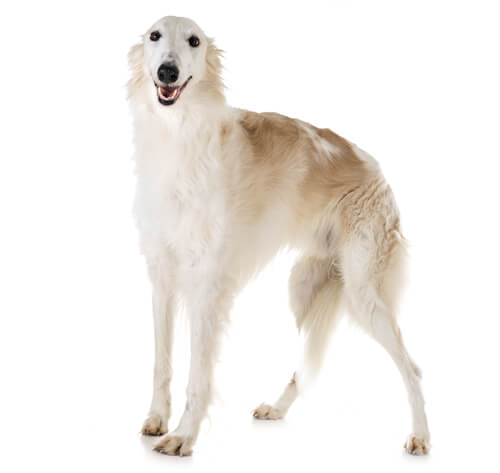
A graceful, elegant sighthound, the Borzoi was bred hundreds of years ago in Tsarist Russia. With his extreme speed, agility and courage, he excelled as a hunter of wolves, foxes and hares. An affectionate family dog, the Borzoi needs daily exercise. His lustrous coat requires regular brushing and bathing.
DID YOU KNOW? The Disney films “Lady and the Tramp” and “102 Dalmatians” feature Borzois.
ALSO KNOWN AS: Barzoï, Russian Wolfhound, Russian Hunting Sighthound, Russkaya Psovaya Borzaya, Psovoi
The need-to-know
- Dog suitable for owners with some experience
- Some training required
- Enjoys active walks
- Enjoys walking an hour a day
- Large dog
- Some drool
- Requires grooming every other day
- Non hypoallergenic breed
- Quiet dog
- Not a guard dog
- May require training to live with other pets
- May require training to live with kids
Personality

As an adult, the Borzoi is a good-natured and gentle dog in the house, taking up surprisingly little space for their size when it suits them. Aloof and reserved with strangers, they can be very affectionate with their own family and exhibit a sense of humour and strong personality that sighthound fans find very appealing.
While not a guard dog, they may alert owners to the presence of suspicious characters and will give good account of themselves if they feel it necessary. Their nature as a sighthound, to course and to chase, must be kept in mind. While they can be raised with cats and small dogs that they view as ‘family’, they will always be predisposed to give chase to fast moving furry objects.
History and Origins

Country of Origin: Russia
As with many breeds, there is some dispute as to the origins of the Borzoi. However, it is likely that Greyhound-like dogs from ancient Egypt were crossed with the native heavier coated herding and pastoral breeds from northern Russia to produce the Borzois ancestors.From the 16th Century onwards the breed became refined into the ultimate wolf catching sighthound, working in pairs to bring down a wolf and hold it until a mounted hunter could dispatch the quarry.
Nutrition and Feeding

Large breed dogs, as well as having large appetites, benefit from a different balance of nutrients including minerals and vitamins compared to smaller-breed dogs. The Borzoi is prone to bloating and stomach problems; smaller, more frequent meals can help minimise this risk.
Exercise

Adult Borzois will be happy with an hour or more’s walking each day, ideally with freedom to run in secure spaces. Younger Borzois must not be over exercised but still need frequent shorter walks and mental stimulation to avoid boredom. Always keep in mind that a sighthound can see movement from some distance and will be inclined to hunt and chase moving objects, and even in play, their play style will involve mock ‘coursing’ which other dogs may find rather off-putting.
Other Information

Health and common concerns
The Borzoi breed is generally a healthy, robust one. As with many breeds, some hereditary eye conditions can occur, and breeding dogs should be eye-tested. Hypothyroidism (an underactive thyroid gland) can be an inherited condition in this breed.
Space requirements
Borzoi is a large breed dog, and whilst they can curl up small when they want to, they do require space to stretch out, a garden suitable for running in and to live within easy reach of secure running space. Due to the time it takes these dogs to mature, Borzois are not suited to going up and down stairs frequently.
Training borzoi dogs
Training the Borzoi requires patience and understanding what motivates them to want to work with you. They will always find running and chasing rewarding, so use this to your advantage where possible, and make training recall a priority, even though it is not advisable to let a Borzoi off lead in an unsecured area. This is not a dog who is likely to enjoy dog training for the sake of training itself. Careful management is needed, as well as training ‘as you go along’ rather than specific training sessions.
Best family dog breeds
The well-trained adult Borzoi can be an excellent family dog, however the immature puppy and adolescent Borzoi may be too exuberant and bouncy for very small children or frail older people. Like all larger breeds, they take some time to grow and mature and need careful management during this time. While many dogs are traditionally thought of as being good with children, all dogs and children need to be taught to get on with each other and be safe together. Even so, dogs and young children should never be left alone together and adults should supervise all interactions between them.
Did you know?
- Captain E J Smith of the RMS Titanic, had a Borzoi called Ben who was famously photographed with him on desk before the ill-feted ship set sail. Thankfully for Ben, he didn’t stay for the voyage.
- For the film Pink Floyd: Live at Pompeii, a Borzoi called Nobs provided lead vocals alongside Dave Gilmour on harmonica and Roger Waters on guitar. The song was ‘Seamus’ named after Dave Gilmour’s dog who originally howled in the studio recording but was re-titled ‘Mademoiselle Nobs’ in the film.